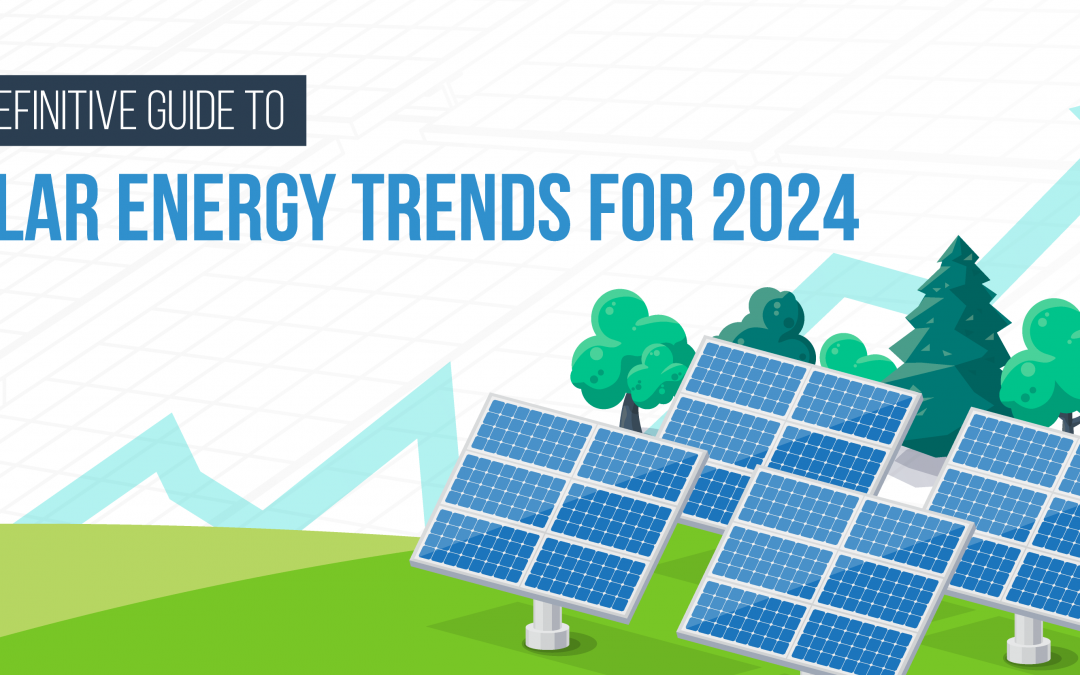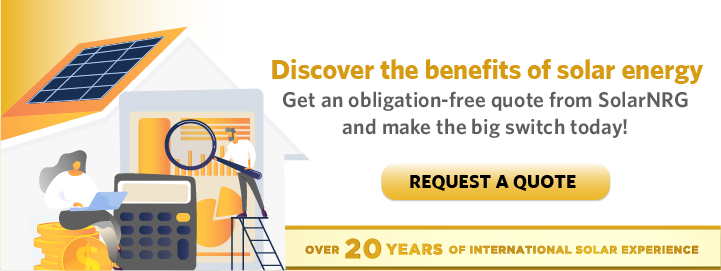Solar energy use is one way of staying ahead of the curve in a world increasingly turning toward sustainable solutions. As recent data shows, industrial solar power accounts for 26% of installations. As 2024 rolls around, solar industry advancements continue with unprecedented growth and innovation.
Groundbreaking solar energy trends in 2024 are shaping the industry, as you’ll learn in this guide.

A Definitive Guide to Solar Energy Trends for 2024
Solar energy is beneficial for the planet and its inhabitants. To help you reap and maximize these benefits, you must know recent solar energy trends that drive the world toward a more sustainable future.
1. Viable solar cells
Traditional silicon-based solar cells have long dominated the market. However, emerging technologies, such as perovskite solar cells (PSC), offer higher efficiency and lower production costs.
PSCs use a special material called perovskite to convert sunlight into electricity through a material with a unique crystal structure. These solar cells are promising because they are relatively inexpensive to produce. They are also structurally flexible, making them useful for various applications, including powering portable devices or integrating them into building materials.
With this innovation, the industry can improve solar energy accessibility and affordability for consumers and businesses. Additionally, research into organic photovoltaics (OPVs) indicates these flexible solar panels can integrate into various surfaces and applications.
2. SMART technology and IoT-integrated solar power
Another commercial solar power trend gaining momentum is the integration of SMART technology and the Internet of Things (IoT) into solar power systems.
For instance, SMART inverters and monitoring systems enable real-time tracking and optimization of solar energy production. In effect, users can maximize energy efficiency while minimizing downtime.
Meanwhile, IoT integration allows remote control and solar panel management, facilitating predictive maintenance and enhancing overall system performance. This trend does more than improve the reliability and performance of solar energy systems. It also paves the way for smart grids and better energy management solutions.
3. Floating solar power farms
Land scarcity can hinder the development of solar power farms. Fortunately, floating solar power farms provide a viable solution to address this problem. This solar energy trend is gaining popularity because it can help optimize energy generation.
Solar panel installations on bodies of water such as reservoirs, lakes, and ponds allow floating solar power farms to use underutilized space while reducing land requirements and environmental impact.
These projects generate clean energy and offer additional benefits, like reduced water evaporation and algae growth. Hence, they are attractive for regions facing water scarcity and environmental challenges.
4. Community solar
Community solar initiatives are on the rise, allowing residents and organizations to invest in and benefit from solar energy projects collectively. These shared solar programs enable households, businesses, and relevant groups to access clean energy without needing rooftop installations or significant upfront investments. Typically, all the users need to do is pay a monthly subscription fee.
More importantly, community solar projects promote equity and inclusivity via pooled resources that let users share the benefits of solar energy generation to accelerate renewable energy adoption.
5. Cost-effective utility-scale solar
The continuous decline of solar panel costs and advancements in utility-scale projects enable the industry to compete with conventional electricity sources. Utility-scale solar projects typically involve large solar installations connected to the grid, benefiting from economies of scale and streamlined deployment processes.
Moreover, government incentives, tax credits, and renewable energy mandates further drive the adoption of utility-scale solar. This industrial solar power solution makes it cost-effective for utilities and consumers alike.
6. Bifacial solar panels
Solar panels have gone through significant technological advancements in recent years. The bifacial version can now capture sunlight from both the front and back sides of the panel. It’s a solar energy trend that helps increase electricity yield and versatility, making it a popular choice for many.
Bifacial panels generate electricity from reflected light, which is ideal for installations in locations with high albedo or varying weather conditions. In addition, bifacial solar panels offer higher efficiency and energy production than traditional monofacial panels. They’re a well-sought commercial solar power source and a valuable solution for utility-scale solar projects.
7. Solar skins expansion
Alternatively known as solar veneers or solar wraps, solar skins are thin film coatings applied to existing surfaces for conversion into solar panels. This innovative technology facilitates seamless solar energy generation for buildings, vehicles, and other structures sans bulky panels. Users can maintain an aesthetically pleasing design while making their structures sustainable.
Consequently, expanding solar skins offers architects, designers, and homeowners greater flexibility and creativity in incorporating clean energy into buildings and homes.
8. Transparent solar panels
Transparent solar panels, or solar windows, are a promising solution for incorporating solar energy into building facades and windows. These translucent panels allow natural light to pass through while capturing solar energy. They can provide both energy generation and daylighting benefits.
Like solar skins, these panels offer architects and building designers a renewable energy solution that enhances building aesthetics and functionality. This solar energy trend promotes sustainable and energy-efficient building design practices.
9. State-of-the-art grid-integrated solar power
This solar energy trend positively alters how the world produces and consumes electricity. Governments and utilities are incentivizing grid-connected solar installations through grants, subsidies, and net metering programs. These initiatives promote renewable energy adoption and grid stability by allowing consumers and businesses to sell excess solar power back to the grid.
Plus, grid-integrated solar power systems enable seamless integration of sustainable energy into existing infrastructure for reduced fossil fuel reliance and lower carbon emissions.
10. Advanced storage solutions
Advanced storage solutions play a crucial role in maximizing the value and reliability of solar energy systems. Particularly, lithium-ion batteries are efficient for storing excess solar energy that can be used during periods of low sunlight or high demand.
Apart from its storage function, these batteries offer high energy density, fast charging capabilities, and long cycle life. They are also a cost-effective storage solution for residential, commercial, and utility-scale solar projects.
11. Solar trackers
Solar trackers are another popular commercial solar power source for optimizing energy generation. These devices orient solar panels to track the sun’s movement throughout the day, which can maximize energy capture and efficiency.
Likewise, they ensure optimal sunlight exposure with continuous adjustments of the tilt and orientation of solar panels. They can increase energy prediction by up to 25% compared to fixed-tilt systems.
Advancements in solar tracker technology, such as dual-axis and smart trackers, enhance tracking accuracy and reliability. These innovations further improve solar energy yield and return on investment.
12. Sophisticated solar inverters
Advanced inverters with features such as MPPT (Maximum Power Point Tracking), reactive power control, and grid support capabilities are becoming increasingly prevalent. Sophisticated solar inverters are essential components of solar energy systems. They convert the DC power that solar panels generate into usable AC power for residential, commercial, and utility-scale applications.
These inverters improve system efficiency, reliability, and grid integration, enabling seamless integration of solar energy into the power grid while ensuring stable and high-quality electricity supply.
Shaping a Sustainable Future with Solar Energy
The solar energy trends of 2024 make a sustainable future within reach. From solar technology advancements to community initiatives, each trend represents a step toward cleaner, more accessible energy solutions.
If you’re considering switching to solar power, SolarNRG can help. We offer innovative solutions tailored to your needs—whether you need solar energy for industrial use or residential upkeep.
Contact us today to learn more.


Recent Comments